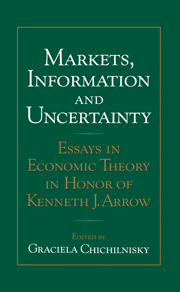Book contents
- Frontmatter
- Contents
- Preface
- List of contributors
- Section I Information and markets
- Section II Uncertainty and finance
- Section III Market externalities and justice
- 8 Moral hazard and independent income in a modern intertemporal-equilibrium model of involuntary unemployment and mandatory retirement
- 9 On the optimal schedule for introducing a new technology, when there is learning by doing
- 10 Price and market share dynamics in network industries
- 11 Exchange in a network of trading posts
- 12 Equilibrium market formation causes missing markets
- 13 Toward a general theory of social overhead capital
- 14 On population externalities and the social rate of discount
- 15 Trade and Welfare
- 16 History as a widespread externality in some Arrow–Debreu market games
- 17 Redistribution by a representative democracy and distributive justice under uncertainty
- Author index
- Subject index
9 - On the optimal schedule for introducing a new technology, when there is learning by doing
Published online by Cambridge University Press: 05 December 2011
- Frontmatter
- Contents
- Preface
- List of contributors
- Section I Information and markets
- Section II Uncertainty and finance
- Section III Market externalities and justice
- 8 Moral hazard and independent income in a modern intertemporal-equilibrium model of involuntary unemployment and mandatory retirement
- 9 On the optimal schedule for introducing a new technology, when there is learning by doing
- 10 Price and market share dynamics in network industries
- 11 Exchange in a network of trading posts
- 12 Equilibrium market formation causes missing markets
- 13 Toward a general theory of social overhead capital
- 14 On population externalities and the social rate of discount
- 15 Trade and Welfare
- 16 History as a widespread externality in some Arrow–Debreu market games
- 17 Redistribution by a representative democracy and distributive justice under uncertainty
- Author index
- Subject index
Summary
Abstract
A known, time-dependent output stream can be produced by either of two technologies. We ask: What mixture of these technologies should be used to minimize the discounted present value of the cost of production? Each technology is characterized by a unit cost function that declines with experience. Typically one of these functions (the “new technology”) starts out higher, but has a lower final asymptote than the other (the “old technology”).
We show that there exists an optimal policy that never uses both technologies at once. We also show that if the two cost functions cross at most once, then there exists an optimal policy that switches at most once.
We also explore two examples. In the first example, output is constant, but the cost of the “new” technology declines exogenously while we are waiting to use it. In the second example, demand jumps abruptly from a lower to a higher constant value. A variety of optimal policies, depending on parameter values, is displayed.
Finally, we discuss what changes in assumptions might lead to optimal policies that are mixed, rather than extreme.
- Type
- Chapter
- Information
- Markets, Information and UncertaintyEssays in Economic Theory in Honor of Kenneth J. Arrow, pp. 165 - 190Publisher: Cambridge University PressPrint publication year: 1999



